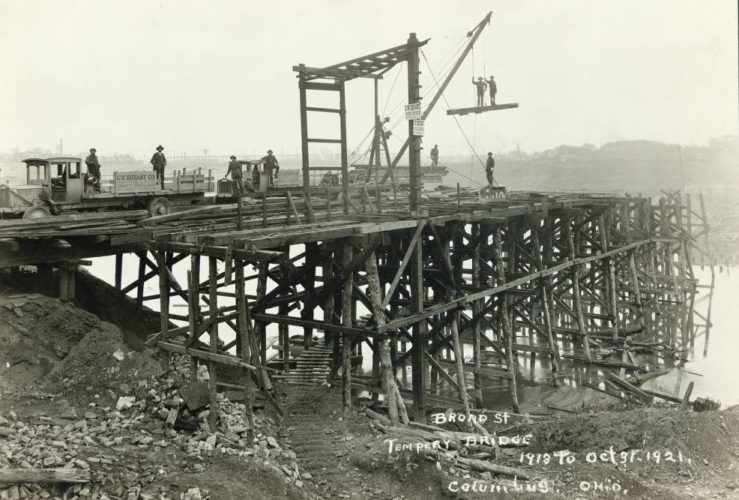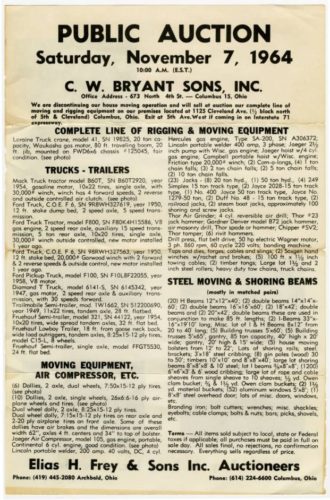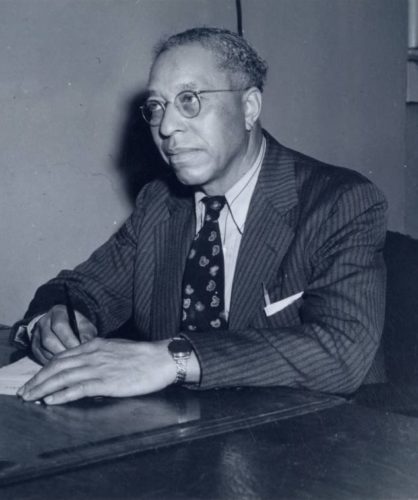C. W. Bryant, Jr.: A Columbus Construction Giant

On November 7, 1964, a public auction was planned in Columbus, Ohio, marking the end of an era for an important local company. The C. W. Bryant Moving and Rigging Company held the auction to sell off heavy equipment and construction material that they had used over several decades in operation, including steel shoring beams, moving trucks and trailers, and even an 80-foot crane! But who was C. W. Bryant? We’re glad you asked!

Charles William Bryant, Jr. was born in Dayton in 1882, and from his start as a young farmhand with a third grade education, he would go on to become a prominent African American businessman, a self-taught engineer, and the owner of one of Columbus’ largest construction firms. At the age of only 16, Bryant made good use of the logs and equipment that he received in payment for his farm work, and leveraged them into his own business that originally used logs and horses to move structures from one site to another. As his business grew, he moved on to using railroad ties and trucks, and later designed his own dollies with rubber wheels.
The C. W. Bryant Rigging & Moving Company (variously referred to as the C. W. Bryant Company, C. W. Bryant and Sons, and other similar names) was involved in major projects throughout Columbus, including the construction of a temporary Broad Street bridge following the 1913 flood (seen above) which earned him respect in the local construction industry early in his career. Other notable work by the Bryant Company included the removal of lighting arches from High Street, partial demolition and renovation of the Ohio Supreme Court Building, renovations at the Ohio Statehouse, construction of South High School in 1923, and the dismantling of Hanford Village in 1962 for the construction of I-71 through town.

For all of his success, Bryant faced stark racial discrimination in his personal and professional life as an African American. In order to purchase the home he wanted in what was then an all-white neighborhood, Bryant had to enlist the help of a white friend to make the all-cash purchase in 1918. Once he and his family had settled in, they experienced ongoing threats from the neighborhood, including a brick thrown through their front window with a drawing of a bomb attached. Bryant was also dedicated to hiring from the African American community, which caused issues when local steelworkers’ unions later refused to admit Bryant’s black employees, forcing the company out of steel construction in the 1950s.
Despite the incredible challenges he faced, Bryant nonetheless expanded his successful efforts into other areas, including ownership of Bryco gas stations, a coal and oil company, the Litchford and Macon hotels, and the Ohio Malt Beverage Co.—the first African American distributor in Columbus—with a popular beer called PeBe 99. Bryant was also an expert in promoting his businesses, with creative stunts like this “2-Car Crash” showing off a Bryant Company crane, and heavy use of advertising signage anywhere the company was involved in work around central Ohio. To see more of the C. W. Bryant Company’s work over the years, and to experience a view of a changing Ohio capital in the first half of the 20th century, we invite you to explore this collection on Ohio Memory!
Thanks to Lily Birkhimer, Digital Projects Coordinator at the Ohio History Connection, for this week’s post!



Leave a Reply
You must be logged in to post a comment.